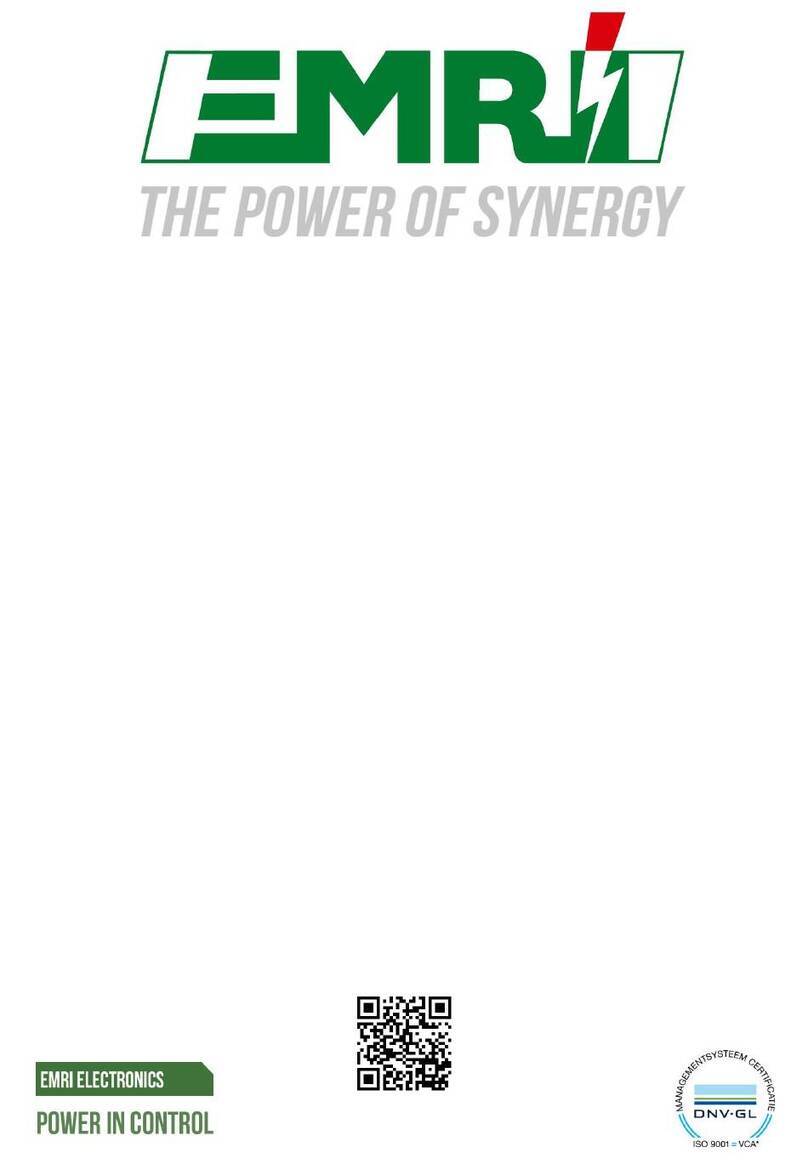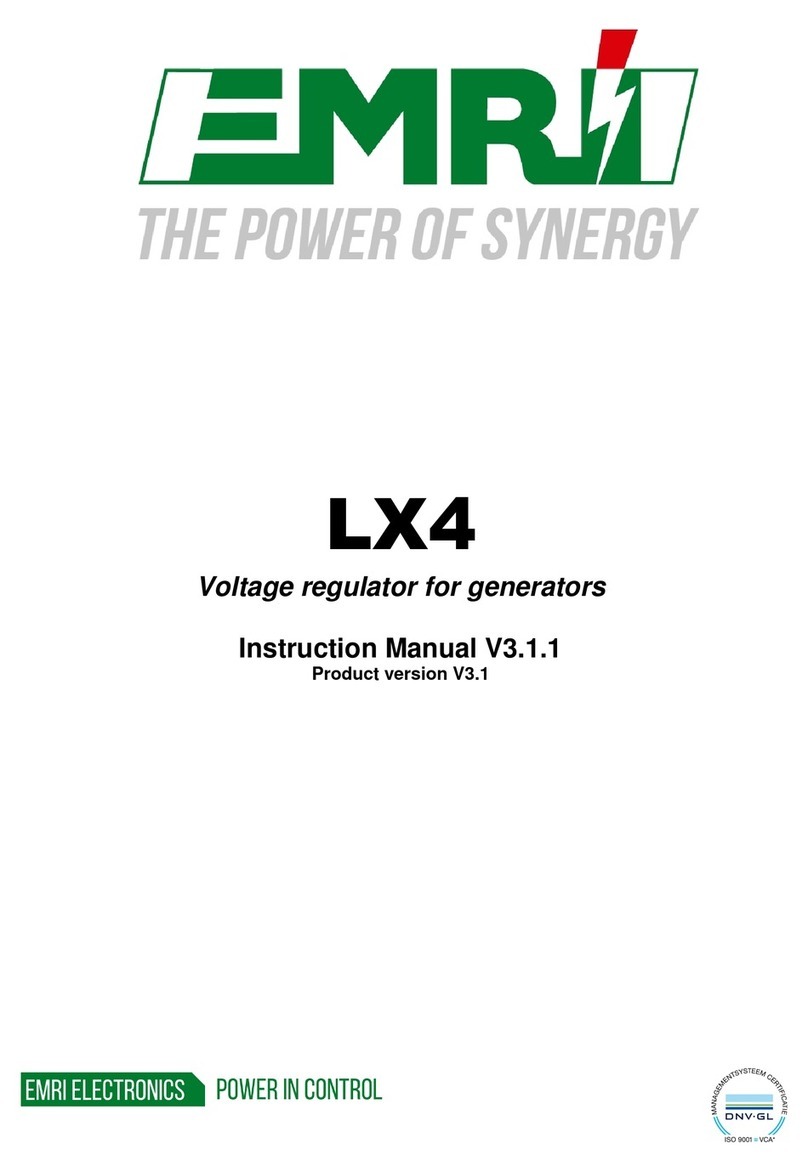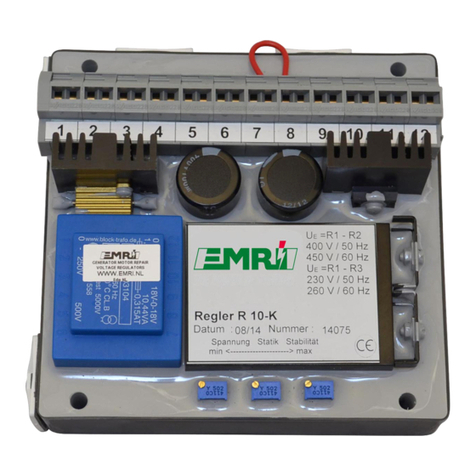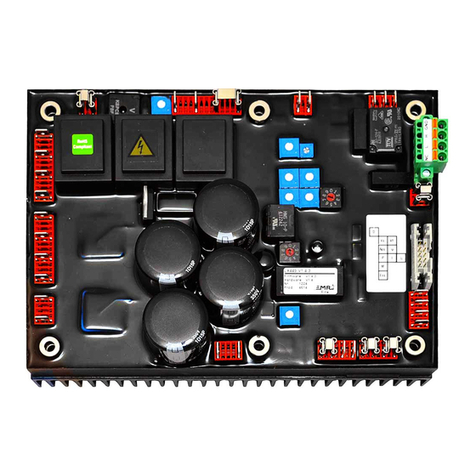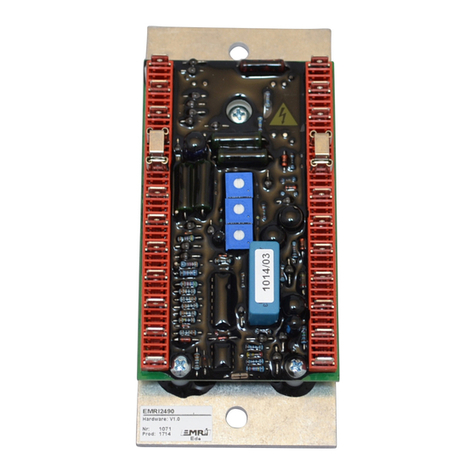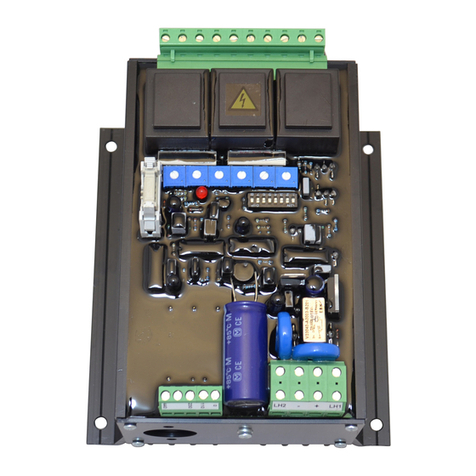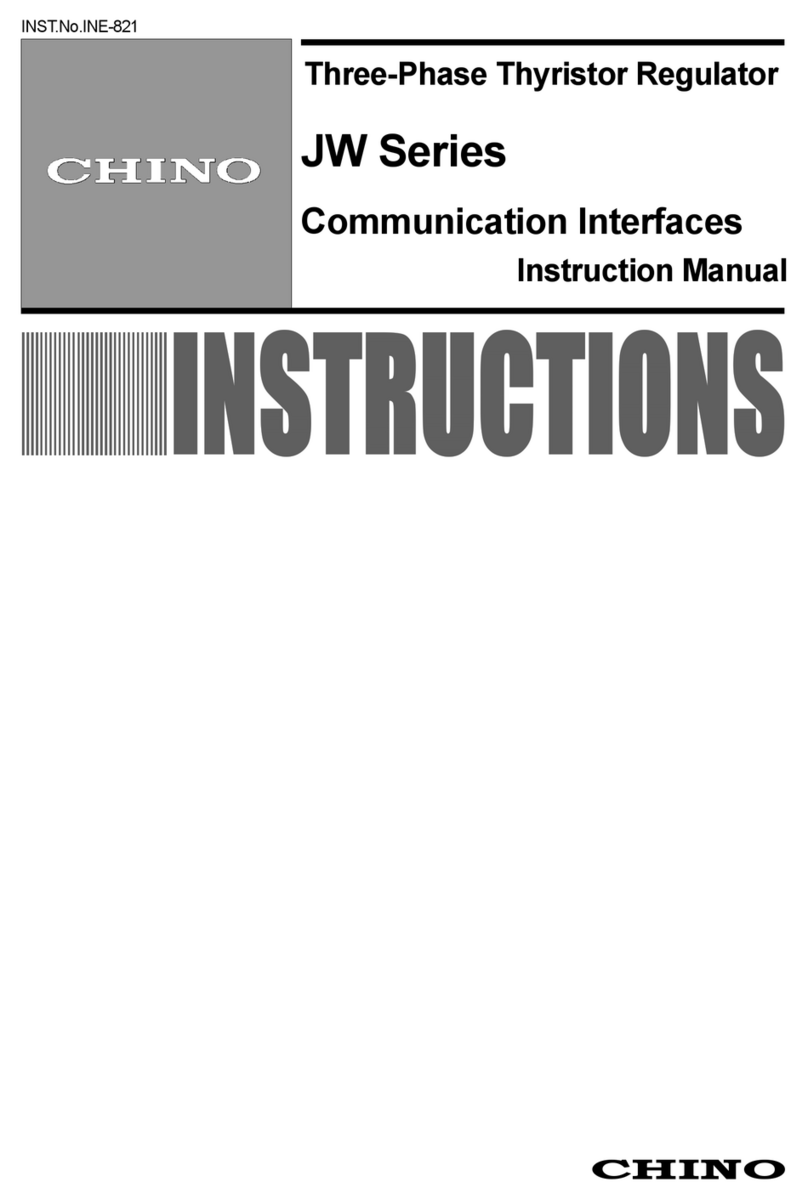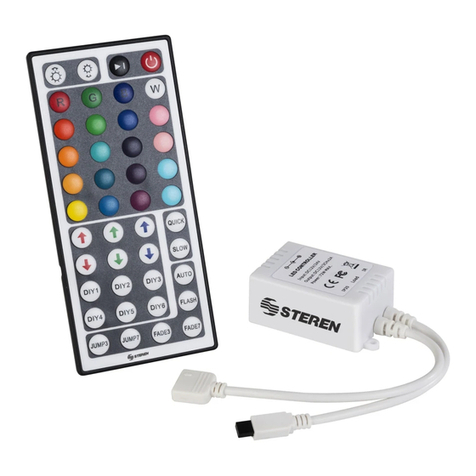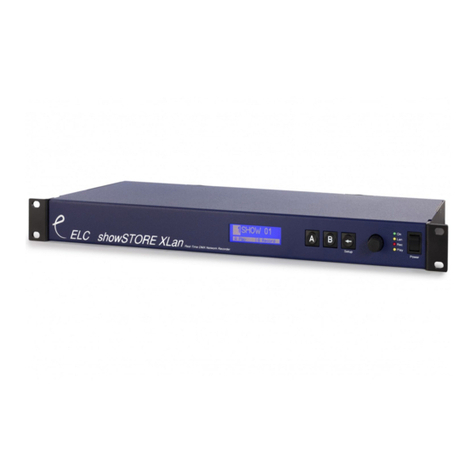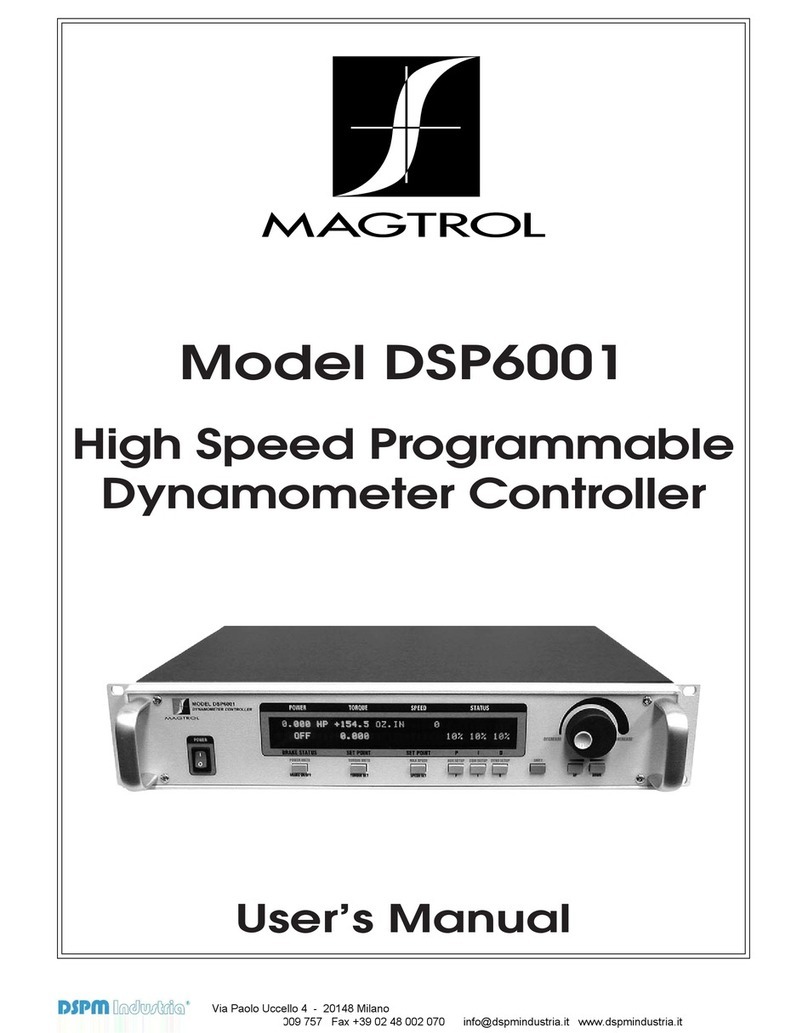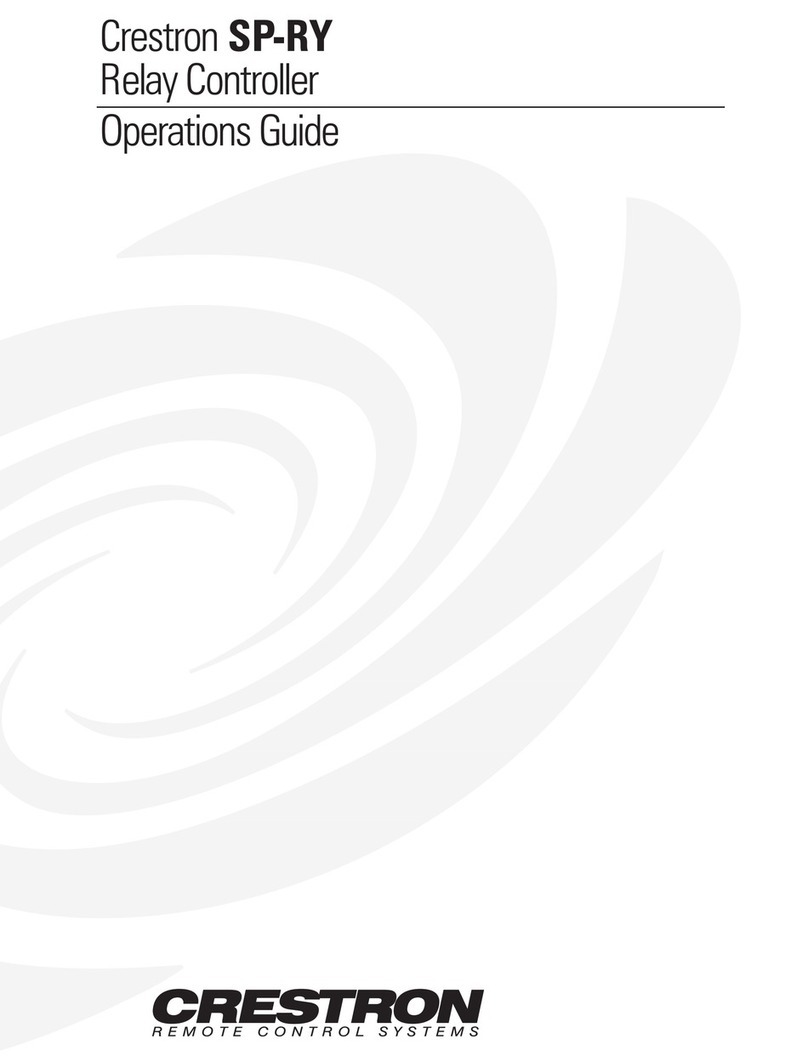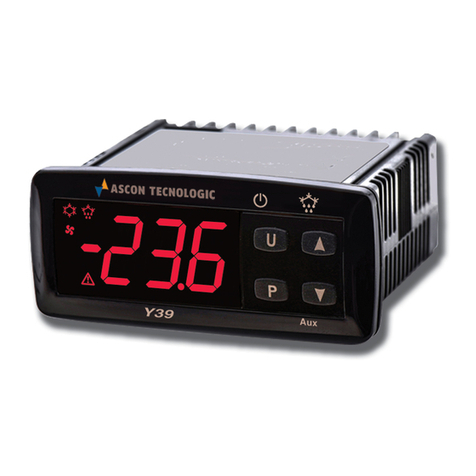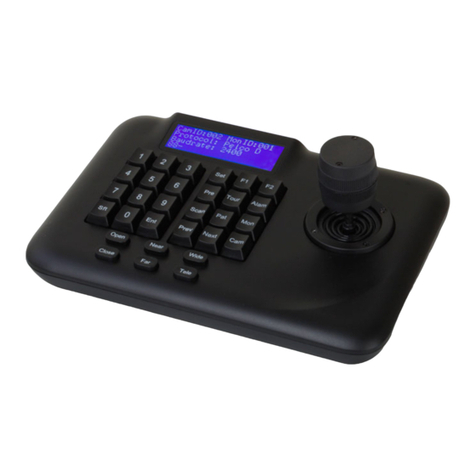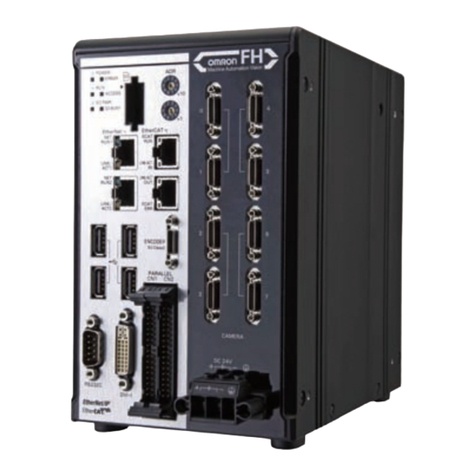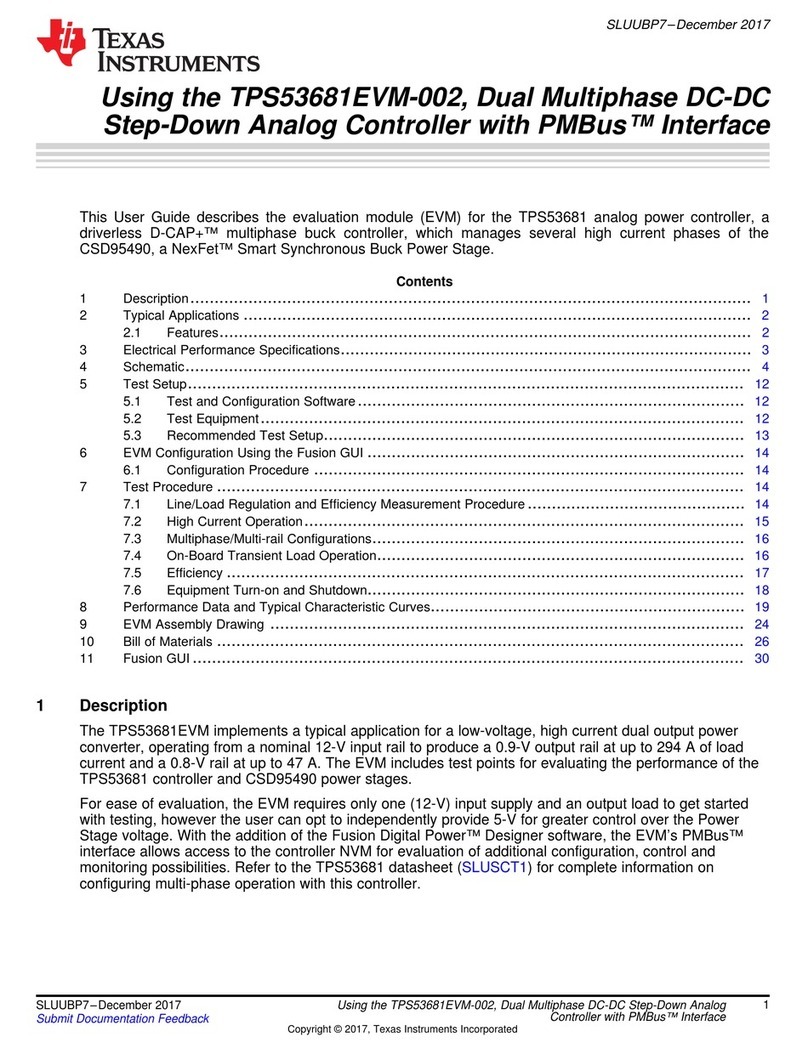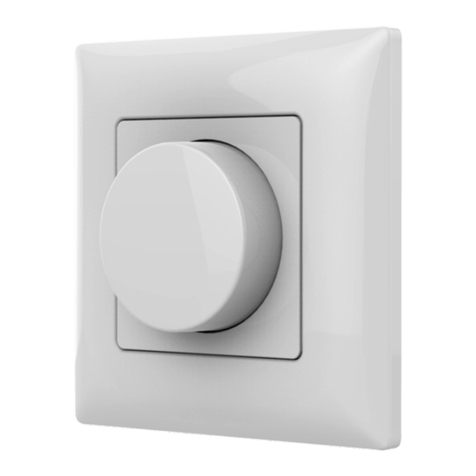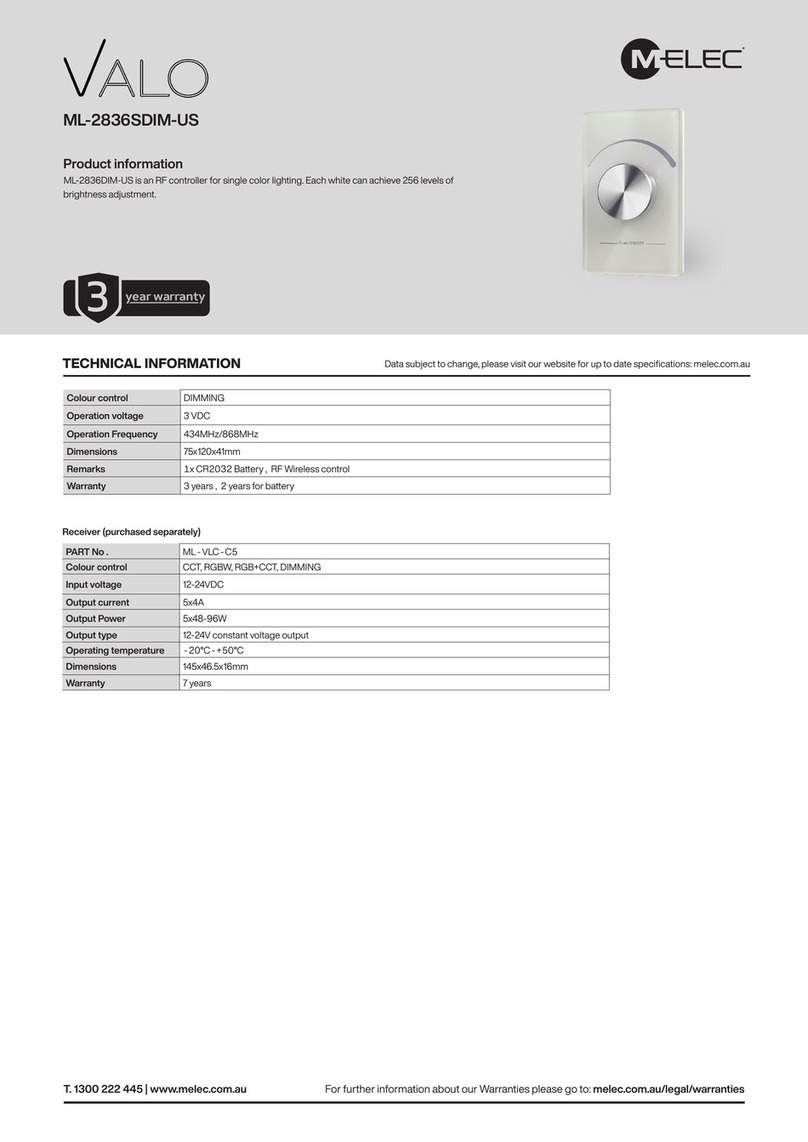EMRI EVA User manual

EVA
Voltage regulator for generators
Instruction Manual V1.3.1
Product version V1.1.1

Manual V1.3.1 Page 2 of 8

Manual V1.3.1 Page 3 of 8
Warnings And Commissioning information
The manual does not cover all technical details of the product. Specifications may be modified by
the manufacturer without notice. For further information, the manufacturer should be contacted.

Manual V1.3.1 Page 4 of 8
EVA
EME / Van Kaick Alternative
CONDITIONS FOR INSTALLATION and COMMISSIONING
Mounting and commissioning of this product may only be done by qualified people with knowledge of electrical machines !
This product is meant to be build in, in a closed cabinet or machine, so that any contact with persons is excluded.
Do not touch the printed cardboard during operation. High Voltage !
Only use isolated measuring instruments.
EMRI bv points out that this product is meant to be assembled as a component in a system or installation on which the following standards take
effect :
89/336 EEG (EMC guidelines)
72/23 EEG (Low voltage guidelines)
General:
The EVA voltage regulator is a replacement for AVR’s : R280/290, Ti7.5D, R260/274, R260/261.
The AVR is also applicable in any generator where the excitation current is within the AVR’s limits,
and there is an auxiliary winding (with voltage within specifications).
The EVA is a constant voltage voltage regulator. An AVR with Volt per Hertz characteristic is available under
type LX4. The LX4 has also PTC -winding temperature input as well as excitation current limitation.
Specifications:
Sensing Voltage
Sensing U,V,W : 3 x 400 Volt 50/60Hz, max. 500 Volt (sine wave)
Sensing U=,V,W=: 3 x 230 Volt 50/60Hz, max. 350 Volt (sine wave)
Supply LH1,LH2,,LH3 and LH4 : 1x 22 Volt up to 1x 100Volt or 3x15Volt up to 3x100Volt
DC or AC untill 400Hz.
Output voltage : Supply voltage
Output current : 4 Amp. continuously 10, Amp. max. (1 Second )
Minimum field resistance : ca. 10 Ohm at 120 Volt supply voltage proportional less on decreasing
supply voltage
Adjustment range :
3 x 400 Volt : print potentiometer (S and T shortened) 275-480 Volt
3 x 230 Volt : print potentiometer (S and T shortened) 165-280 Volt
Accuracy : < 1%
Self excitation : from 3 Volt remanent magnetism voltage
Connectors : not mutually exchangeable
Droop input : 0.5 A > 1 VA
Sizes : L x W x H : 130 x 150 x 77mm
Weight : 890 gram
Max. temp : 40
o
C
Protections:
Under speed trip (Ftrip) : Adjustable between 40 en 60 Hz and jumper to enable - disable Ftrip
Fuse : 6.2 x 32 mm 10 A Ultra Rapid

Manual V1.3.1 Page 5 of 8
Monting and connection
The AVR is preferably mounted on vibration studs. When placed inside a closed cabinet, sufficient cooling
masu be obtained. The connection is according the circuit diagram, where as some generators may differ a
little, but the inputs LH1 - LH4 are not sensitive for which winding on which terminal.
The terminal LH1, LH2, LH3 and LH4 are the supply voltage terminals. These terminals are electrically
connected to the terminals S, T, +_and -. The terminals 1 and 2 are only used for connecting a droop
transformer when parallel operation is necessary. If not used these terminal can be shortened. The supply
LH1 - LH4 may also be sourced by any auxiliary voltage, as long as this voltage is disconnected when the
generator is not running.
Frequency ( underspeed) trip
The regulator has a built-in Frequency trip function. This function drops the Generator voltage to
approximately 50% of the nominal value, when the generator frequency comes below the adjusted value.
The factory adjustment is 45 Hz. Adjustment is made at nominal frequency by turning the potentiometer
counter clock wise until the voltage decreases. Then turn it the other direction until the red LED just goes out.
The frequency of the generator is determined by its rotating speed.
The voltage regulator can not adjust the actual frequency. Do not run the generator on lower speed for longer
periods, since this may cause damage to generator and AVR.
The frequency trip may be disabled with the jumper switch.
Self excitation circuit
The EVA voltage regulator has a build in self excitation circuit, which operates from 3 Vac up. This circuit is
connected to the terminal LH4.
When only one auxiliary winding is present in the generator to supply the avr, do parallel the supply inputs
LH1 and LH3, LH2 and LH4 to divide the current over more input rectifiers.
Parallel operation
If the generator operates in parallel operation with one or more generators, reactive load sharing can be
accomplished by means of Quadrature Droop Compensation (QDC). Parallel operation requires an EMRI
droopkit. The droopkit must be rated to match the generator nominal current.
In order to obtain a proper load distribution the no-load voltages and the amount of voltage droop during load
must be set equal for all generators. The adjustments must be made very precise and under equal conditions
for each generator (frequency, current, power factor)
The influence of the voltage droop on the generator voltage is depicted in diagram 2.
Diagram 2. Voltage droop

Manual V1.3.1 Page 6 of 8
Wiring diagram

Manual V1.3.1 Page 7 of 8
General installation information
Absolute Maximum Ratings
- The Absolute Maximum Ratings are those limits for the device that, if exceeded, will likely damage the device. Exceeding the
absolute maximum ratings voids any warranty and/or guarantee.
Mounting
Mounting of the product should be done in such a way that:
-the absolute maximum ambient temperature rating of the product will never be exceeded.
-maximum cooling (direction of cooling ribs and direction of airflow) is achieved.
-Mounting no humid air can flow through the product or condensation occurs.
-dust or other materials or residue will not remain in or on the product.
-the maximum vibration is not exceeded.
-personal contact with persons is impossible.
Wiring
-Diameter size of the wiring should be enough to carry the expected current. Wire insulation should be enough to withstand
the expected operating voltages and temperatures.
-To improve EMC emission and immunity, care should be taken for the lay out of the wiring. This in respect to all wiring in the
installation.
-Keep current carrying wires as short as possible.
-Keep wires carrying a total sum of zero Ampere close to each other, or in one single cable, E.g. U, V, W, or X (+) and XX (-),
or Phase and neutral, or S and T.
-Avoid current carrying conductors next to sensing or control wiring. Especially current controlled by SCR’s or PWM controlled
transistors.
-If sensitive sensing signal cables need to be laid across distance along other cabling, shielded cable is preferred. Keep the
shield as long as possible and the wiring outside the shield as short as possible. Do not solder or shrink the shield to a
regular wire. Connect the original shield to ground at one side with an as large as possible contact surface.
Additional installation information
- When the product is supplied by means of a transformer, it should never be an auto-transformer. Auto-transformers react as
voltage sweep up coil and may cause high voltage peaks.
-Standard fit capacitors or over-voltage suppressers across X (+) and XX (-), or exciter field terminals inside the generator
should be removed.
-When the product is supplied by means of a transformer, it should be able to carry at least the maximum expected current.
Advisable is, to have a transformer which can carry twice the maximum expected current. Inductive loads make voltage sacks
and peeks into the secondary voltage of a transformer, from which the device may malfunction.
-It is not recommended to apply switches in dc outputs. It is preferred to use switches in the ac supply inputs of devices. In
case it is unavoidable to have switches in the dc output of a device, action must be taken to avoid over voltage damage to the
device due to contact arcing. Use a voltage suppressor across the output.
-It is not recommended to apply switches or fuses in the sensing lines. Defects can cause high voltage situations due to over-
excitation.
-When using a step down transformer in medium or high voltage generators, the transformer should be three phase (if three
phase sensing), and the transformer should be suitable for acting as a sensing transformer. If the transformer is unloaded,
connect a resistor to avoid voltage waveform distortion.
-The phase relation from the generator to the AVR is important. Also when voltage transformers and/ or current transformers
are installed.
-When using a step down or insulation transformer in the droop circuit, phase relation from the generator to the AVR is
important.
-CT’s wiring, connected to the AVR should never be grounded.
-Always disconnect electronic products, circuits and people before checking the insulation resistance (Megger check).
-Due to differences in generators impedance’s, EMC behavior is not predictable. Therefore the commissioner / installer should
be aware of proper and correct installation.
-Large, highly inductive, exciter stator windings can cause destructive high voltage peaks. Adding a resistor from 10 to 20
times the exciter stator field resistance reduces voltage spikes. If necessary filter can be fitted additionally. (e.g. snubber, RC-
network)
-Upon problems during commissioning, faulty behavior or defects in the generator, consult the fault finding manual at our web
site
-Some advises may be overdone or seem extraordinary, but since the electrical rules are the same everywhere, these advises
are given.

Manual V1.3.1 Page 8 of 8
Contact
EMRI Electronics B.V.
Manufacturer
Morsestraat 10
6716 AH, Ede, Netherlands
Tel: +31 (0)318 620 427
Website: www.emri.nl
E-mail: [email protected]
ICELAND,
Hafnarfjordur
Rafeining ehf
Tel: +354 565 3049
Fax: +354 565 3048
Website: www.rafeining.is
E-mail: rafeining@rafeining.is
POLAN
D,
Gdynia
An-Elec Sp. z o.o.
Tel: +48 58 668 44 00
Fax: +48 58 668 44 66
Website: http://an-elec.pl
E
-
mail:
info@an
-
elec.pl
INDIA,
Faridabad
Power Solutions
Tel: +91 9868907903
Fax:: +91 129 2431216
Website: www.psolindia.com
E-mail: [email protected]
SOUTH AFRICA,
Roodepoort
Yneldo Electronics
Tel: +27(0)117637053
Fax: +27(0)117634212
Website: www.yneldo.com
E
-
mail:
POLAND,
Szczecin-Mierzyn
Marel Serwis
Tel: +48 91 48 58 388
Fax: +48 91 48 79 948
Website: www.marel.szczecin.pl
E-mail: handel@marel.szczecin.pl
CHILE,
Santiago
Lucio Vicencio y CIA.LTDA
Tel: +1-281-334-2904
Fax:: +1-832-221-5642
Website: www.luciovicencio.cl
E
-
mail:
NORWAY,
Bergen
Frydenbø Electric A/S
Tel: +47 55 34 91 00
Fax: +47 55 34 91 10
Website: www.frydenbo.no
E-mail: firma.fel@frydenboe.no
SINGAPORE,
Singapore
Cyclect Electrical Engineering
Tel: +65 6868 6013
Fax: +65 6863 6260
Website: www.cyclect.com.sg
E-mail: heng.p@cyclect.com.sg
THAILAND,
Bang Lamung
Semtec Maritime/Genetech Co.Ltd
Tel: +66 38301262
Fax: +1-832-221-5642
Website: semtecmaritime.com/
Email
:
UNITED
ARAB
E
MIRATES,
Sharjah
KDU Technical Services
Tel: +971-6-5575480
Fax: +971-6-5575490
Website: www.kdutech.ae
E
-
mail:
SWEDEN,
Kungälv
Elektrisk Drivteknik EDT AB
Tel: +46-705-28 20 60
Tel: +46-709-50 47 90
Website: www.edtab.se
E
-
mail:
GREECE,
Piraeus
Stavros Kassidiaris S.A.
Tel: +30 210 4636000
Fax: +30 210 4624471
Website:www.kassidiaris.gr
E
-
mail:
CANARY ISLANDS,
Las Palmas
Zamakona Yards
Tel: +34 928467521
Fax: +34 928461233
Website: www.zamakonayards.com/
E
-
mail:
UNITED KINGDOM,
Stockton on Tees
MJR Controls
Tel: +44 1642 762 151
Fax: +44 1642 762 502
Website: www.mjrcontrols.com
Email:
UNITED STATES,
Kemah - Texas
Ramtec Marine Systems LLC
Tel: +1-281-334-2904
Fax: +1-832-221-5642
Website: www.ramtec-marine.com
Email:
waling@ramtec
-
marine.com
REPUBLIC OF PANAMA,
Panama
PASRAS S.A.
Tel: +507 3140095
Fax: +507 3140094
Website: www.pasras.com
E-mail: [email protected]
ROMANIA,
Constanta
SAMTEC SRL
Tel: +40 241 517 047
Fax: +40 241 517 047
Website: www.samtec.ro
E-mail: [email protected]
UNITED KINGDOM,
Cheadle Hulme
TGS Total Generator Solutions Ltd
Tel: +44161 8188720
Fax: +447754677963
Website: http://totalgeneratorsolutions.com
Email:
POLAND,
Szczecin
MARCONTREL
Tel: +48 91 4 888 474
Fax: +48 91 4 888 475
Website: www.marcontrel.com
E
-
ma
il:
TURKEY,
Izmir
INTEGRAL
Tel: +90 (555) 211 55 75
Email: [email protected]om
Table of contents
Other EMRI Controllers manuals
Popular Controllers manuals by other brands
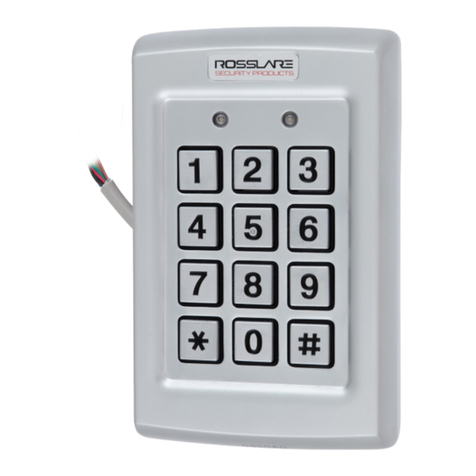
Rosslare
Rosslare AYC-Q54B Installation and programming manual
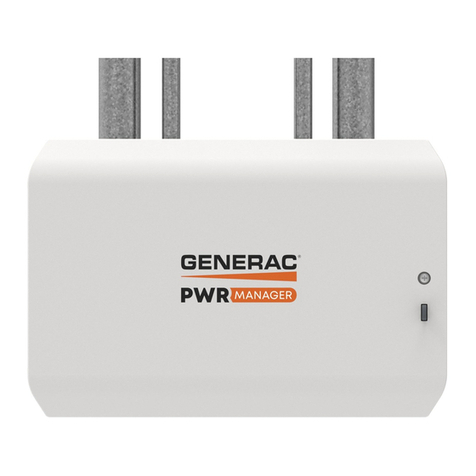
Generac Power Systems
Generac Power Systems PWRmanager owner's manual

Rockwell Automation
Rockwell Automation Allen-Bradley Logix5000 Programming manual
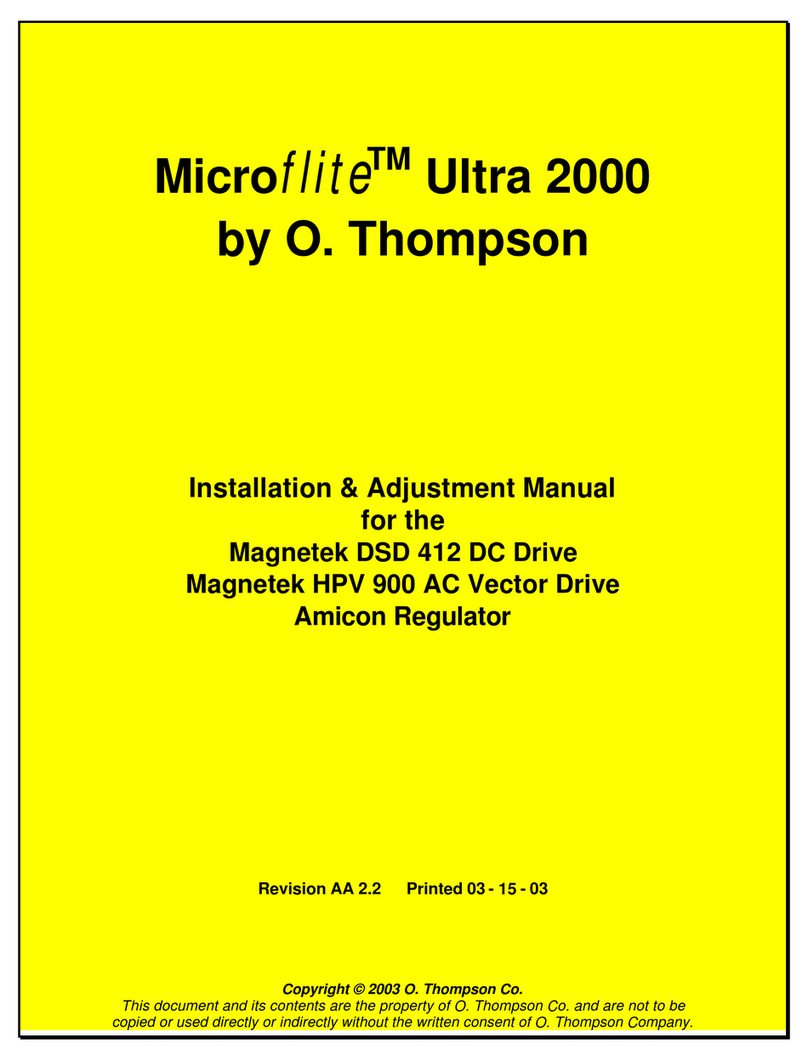
O. Thompson
O. Thompson Microflite Ultra 2000 Installation & Adjustment Manual
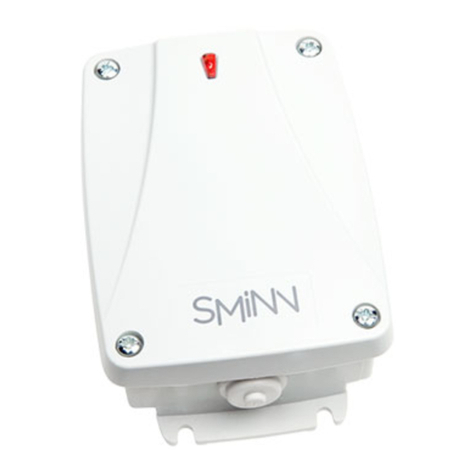
Sminn
Sminn BOX S 220 instruction manual

Denison Hydraulics
Denison Hydraulics Jupiter 900 manual
